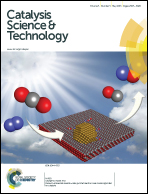Biobased catalyst in biorefinery processes: sulphonated hydrothermal carbon for glycerol esterification†
Abstract
Sulphonated hydrothermal carbon (SHTC), obtained from D-glucose by mild hydrothermal carbonisation and subsequent sulphonation with sulphuric acid, is able to catalyse the esterification of glycerol with different carboxylic acids, namely, acetic, butyric and caprylic acids. Product selectivity can be tuned by simply controlling the reaction conditions. On the one hand, SHTC provides one of the best selectivity towards monoacetins described up to now without the need for an excess of glycerol. On the other hand, excellent selectivity towards triacylglycerides (TAG) can be obtained, beyond those described with other solid catalysts, including well-known sulphonic resins. Recovery of the catalyst showed partial deactivation of the solid. The formation of sulphonate esters on the surface, confirmed by solid state NMR, was the cause of this behaviour. Acid treatment of the used catalyst, with subsequent hydrolysis of the surface sulphonate esters, allows SHTC to recover its activity. The higher selectivity towards mono- and triesters and its renewable origin makes SHTC an attractive catalyst in biorefinery processes.


 Please wait while we load your content...
Please wait while we load your content...